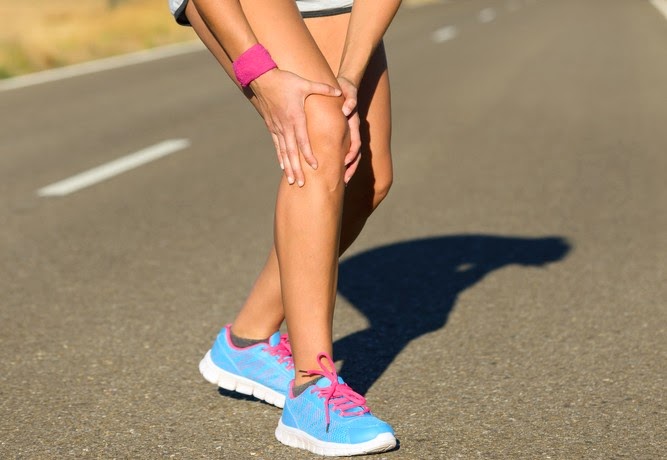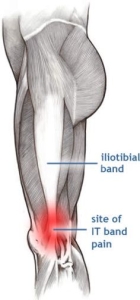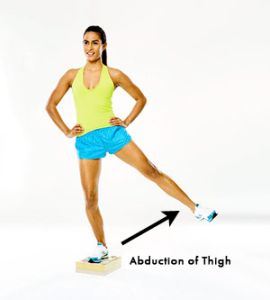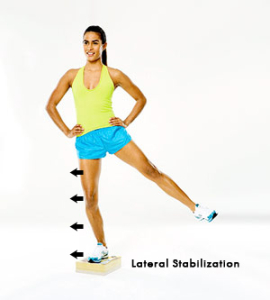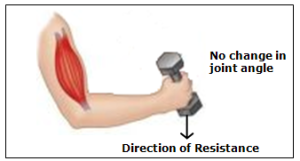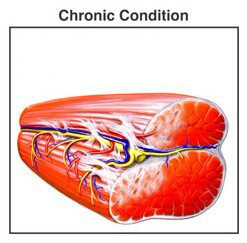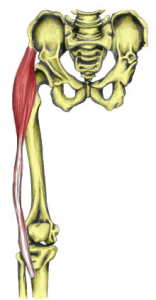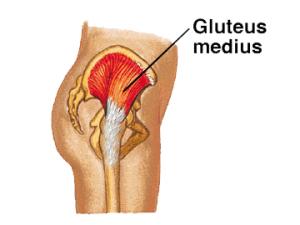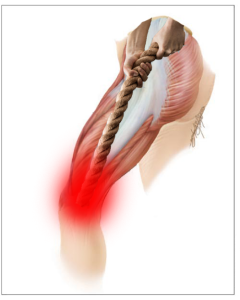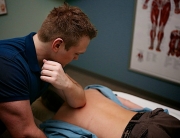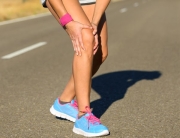Most runners are no stranger to a little pain. But what happens when it persists? It begins as an ache down the outside of your thigh just above the knee. You run through the pain. Soon, you are experiencing full-out knee pain, even when you aren’t running.
Have your knees finally given out? Are your running days over? Suddenly you hear the voices of everybody preaching ellipticals over the years…
The Good News
The chances are good you are simply experiencing ITBS (Iliotibial Band Syndrome) This is the most common complaint among runners, and it actually has a pretty simple fix.
The primary symptoms of ITBS are pain and swelling on the outside of the knee, so many runners mistakenly believe they have a knee injury.
If you read the information below and follow through on it, we will have you back to full stride in no time.
You Have Been Mislead
If you know anything about ITBS, then you know R.I.C.E. (Rest. Ice. Compression. Elevation.) is the typical recommendation for treatment. The problem is that it doesn’t FIX anything.
Modern medicine is famous for temporarily addressing SYMPTOMS, but NOT CAUSES. The case is no different here.
Because of the location of the pain, the IT Band itself has been thought to be the cause. Therefore, the common treatments are aimed at addressing only the IT Band. As you will see, this is a very limited viewpoint.
Your goal should be to find the actual cause, and eliminate it. This article will show you how to do that.
The Root Cause Of IT Band Pain
Imagine this scenario… Two men tie a rope around your knee and begin pulling you toward them. You stand your ground. Your knee hurts where the rope is tied. What is the actual cause of the pain? Your knee? The rope? The men? Keep this scenario in your mind as you read on…
At The Muscle Medics, we are anatomy nerds, but you probably aren’t, so we will keep the anatomy lesson as short as possible. Understanding the structures that are causing your pain is essential in eliminating it. So pay attention now, and soon you will be back to running PAIN-FREE! You can also know more about how to get rid off muscle pain in Lake Charles.
DISCLAIMER: This is the DETAILED VERSION. If you are short on time, or just want a less scientific explanation, please visit the EASY VERSION.
The IT Band
It is generally accepted that the IT Band serves two primary functions: Assisting with abduction of the thigh (Figure 1) and lateral stabilization of the thigh and outer knee (Figure 2)
Now observe the leg she is standing on. THAT is lateral stabilization of the knee. Incredible pressure is being placed on the knee, IT Band, and also her load-bearing hip.
Stand up and adopt the pose above. Note the feeling on the outside of your entire load-bearing leg. If you hold this pose long enough, that hip will begin to shake (Muscle fatigue from the Static Contraction) This is where it gets important for runners…
The point here is that the same exact muscles are active on both sides. Thigh abduction and lateral stabilization are basically the same movement. When the leg is free, the contraction results in thigh abduction seen in figure 1. When the weight is supported by that leg, the effort results in lateral stabilization, as shown in figure 2.
The important thing to learn is that the muscles in figure 2 are performing what is called STATIC CONTRACTION. They are flexing against resistance, but aren’t moving anywhere.
Prolonged or repetitive static contraction is the worst thing for voluntary muscles (More on that soon)
Why Is This Important For Runners?
Running is a unidirectional movement, meaning you are only trying to go one way, forward. This also means your lateral stabilizers are doing extra duty to keep you from tipping over sideways. It gets worse. Notice how the angle of the load-bearing leg gets more severe while running…
This exaggerated angle magnifies the problem because it increases the load on the lateral stabilizers.
If you have any experience lifting weights, you will remember that everybody tells you to use a FULL RANGE OF MOTION. Muscles like full ranges of motion. They want to contract all the way, and then lengthen all the way.
When muscles are REPEATEDLY CONTRACTED IN A STATIC POSITION, they develop knots, and unhealthy connective tissue builds up in the muscle due to lack of proper circulation and micro-tearing.
Imagine how many steps you take in just a single running session. If you have been running for years, chances are very good that your lateral stabilizer muscles look like this…Once they reach this state, the muscles place CONSTANT STRAIN onto the tissues they are connected to. In this case, the lateral stabilizers are connected to, you guessed it, the IT BAND!
Which Muscles Are Causing The IT Pain?
Now that we know problematic lateral stabilizers are the true culprit, let’s take a look at which muscles we are talking about.
Tensor Fascia Lata (TFL)
It is easy to see that the TFL muscle is directly connected to the knee joint through the IT Band. Notice how the muscle actually BECOMES THE IT BAND? Any contraction (Or attempted contraction in this case) will have a direct impact on both the IT Band and the knee.
Gluteus Medius
Take a look at where the Gluteus Medius attaches to the thigh bone and turns white. That tendon actually INTEGRATES INTO THE IT BAND! So this muscle has a direct impact on the knee via the IT Band.
This next visual should illuminate the situation perfectly…
Ultimately, the pressure isn’t coming from the IT Band itself. Solidified, afflicted MUSCLES are constantly pulling on it, resulting in inflammation and pain around the knee. If any of this was confusing, please visit the EASY VERSION for a faster understanding.
How Do We Eliminate The Pain?
Let’s revisit the scenario of the two men pulling on the rope tied to your knee. To stop the pain you have three options:
1) Ice, rest, compress, or inject steroids into your knee to numb the pain.
2) Cut part of the rope to relieve some of the tension (They actually DO this to the IT Band!)
3) “Convince” the men to stop pulling on the rope! (Maybe with a swift kick in a tender spot?)
Obviously, option number 3 makes the most sense.
We have found that by “convincing” the Gluteus Medius and TFL muscles to stop pulling on the IT Band, the resulting pain decreases almost instantaneously.
How Do We Effectively “Convince” The Muscles?
Once a muscle has reached the chronically hardened state pictured earlier, there is only ONE way you can fix it. You have to manually break down the tissue to restore proper blood flow, and your body will heal it back with healthy muscle tissue. After the unhealthy tissue is broken up, the pressure on the IT Band dissipates, along with the pain.
Stretching alone doesn’t work. Imagine stretching a rubber band with a knot in the middle; the sides will stretch, but the knot remains stuck. The affected tissue has to be broken down directly.
That’s Where We Come In…
With over 12 years of clinical experience in the pain-relief industry, we have seen and fixed this condition countless times. We even have a routine named after it!
By making an appointment and getting checked out by us now, you’ll:
- Get out of pain faster
- Find out whether or not there is already knee damage
- Prevent permanent knee damage by clearing it up early
- Learn techniques you can do at home to help you recover more quickly
- Get back to running pain-free ASAP!
Remember the best surgery is always the one you prevented. If you are still in the beginning stages, the time to act is NOW.
As always, please feel free to email or call us with any concerns about your specific situation. We will do our best to answer any questions you may have.
Safe running!
The Muscle Medics
Are You Ready For RELIEF?
Try our 'Runner's Relief' routine and feel the benefits for yourself!
Schedule Now
